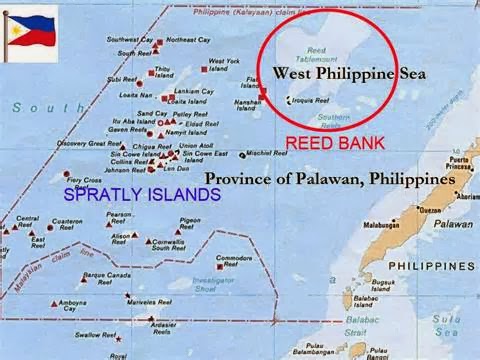China must accept the provisions of UNCLOS
 China has again used its naval might to bully Filipino fishermen who were taking shelter due to bad weather 40 yards off the shore of the Bajo de Masinloc, which is inside the Exclusive Economic Zone of the Philippines.
China has again used its naval might to bully Filipino fishermen who were taking shelter due to bad weather 40 yards off the shore of the Bajo de Masinloc, which is inside the Exclusive Economic Zone of the Philippines.An exclusive economic zone (EEZ) is a seazone prescribed by the United Nations Convention on the Law of the Sea over which a state has special rights over the exploration and use of marine resources, including energy production from water and wind.[1] It stretches from the baseline out to 200 nautical miles from its coast. In colloquial usage, the term may include the continental shelf. The term does not include either the territorial sea or the continental shelf beyond the 200 n.m.limit. (http://en.wikipedia.org/wiki/Exclusive_Economic_Zone)
The incident took place a few days when the Chinese Coast Guard deliberately bombarded two Filipino fishing vessels with a water cannon as a means to drive them away from the area.
Although Philippine Foreign Affairs spokesman Raul Hernandez told media in a presscon that no one of the fishermen were seriously injured during the bullying tactics made by the Chinese coast guards. And it couldn't be immediately ascertained if the action of the Chinese coast guards was authorized by the central government of China.
Hernandez said that this is not the first time that China did it to Filipino fishermen. There were instances in the past when the same bullying tactics were used to intimidate or drive away Filipino fishermen whose only purpose in the area was to catch fish, he said.
Why drove the Chinese Coast Guards to do this stupid action?
The foreign affairs official said that China continues to believe that the whole of the South China Sea belongs to them. The Chinese government has insisted that most of the islands and atolls in the area, including those being claimed by the Philippines and other Asean member countries, are theirs. Reports showed that China's claims are supported by history.
As a signatory of the United Nations Convention on the Law of the Seas (UNCLOS), it could have contested the matter before affixing its signature to the agreement. But it didnt? Now, it is trying to bully a small country like the Philippines, claiming that most, if not all, of the areas in the South China Sea are part
of Chinese history.
If China doesn't believe in the mission of the UNCLOS, it might as well dismember itself as part of the United Nations. Understandably, the UNCLOS made it clear in its definition of the "continental shelf and the criteria for the establishment of its outer limits", yet it seems China pretends to be unaware of such a
policy.
The definition of the continental shelf and the criteria by which a coastal State may establish the outer limits of its continental shelf are set out in article 76 of the Convention. In addition, the Third United Nations Conference on the Law of the Sea (the "Conference") adopted on 29 August 1980 a "Statement of
Understanding" which is contained in Annex II to the Final Act of the Conference.
The term "continental shelf" is used by geologists generally to mean that part of the continental margin which is between the shoreline and the shelf break or, where there is no noticeable slope, between the shoreline and the point where the depth of the superjacent water is approximately between 100 and 200 meters. However, this term is used in article 76 as a juridical term.
According to the Convention, the continental shelf of a coastal State comprises the submerged prolongation of the land territory of the coastal State - the seabed and subsoil of the submarine areas that extend beyond its territorial sea to the outer edge of the continental margin, or to a distance of 200 nautical miles where the outer edge of the continental margin does not extend up to that distance. The continental margin consists of the seabed and subsoil of the shelf, the slope and the rise. It does not include the deep ocean floor with its oceanic ridges or the subsoil thereof .
According to article 76, the coastal State may establish the outer limits of its juridical continental shelf wherever the continental margin extends beyond 200 nautical miles by establishing the foot of the continental slope, by meeting the requirements of article 76, paragraphs 4 - 7, of the Convention...(http://www.un.org/Depts/los/clcs_new/continental_shelf_description.htm#definition)


Comments